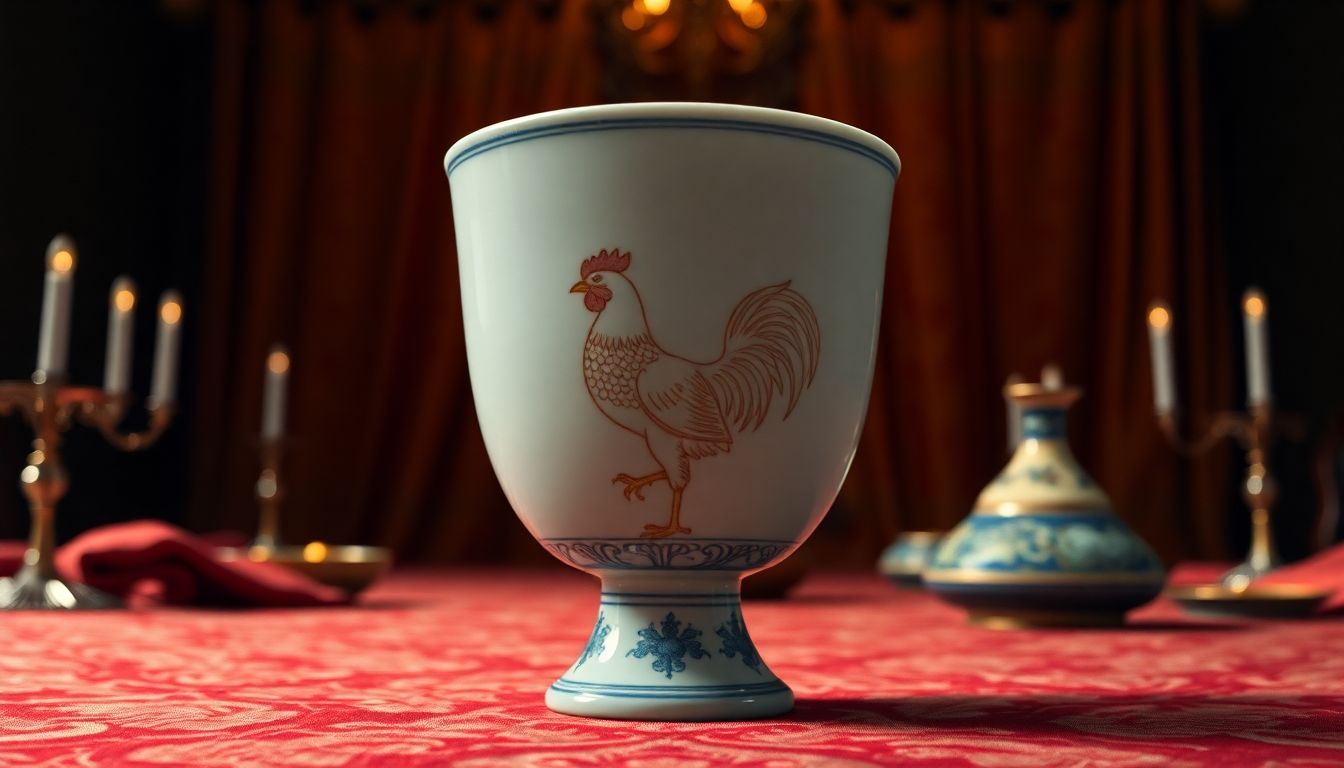
Decoding the Dynasty: Why Chickens Adorned the Chenghua Emperor's Wine Cups?
Introduction: A Feathered Enigma in Imperial China
The Chenghua Emperor’s reign, which lasted from 1465 to 1487, stands out in the history of China's Ming Dynasty. One of the most fascinating artifacts from this period is the chicken motif found on wine cups used by the emperor. This peculiar design raises questions about its significance and the cultural ideals of the time. So, why a chicken, and what does it truly represent?
The Allure of the Chenghua Reign and its Porcelain
The Chenghua period is noted for its exquisite porcelain, embodying both artistic finesse and technological advancements. Potters and artisans flourished under the emperor's patronage, turning porcelain into a celebrated art form. It was during this golden age that motifs like the chicken emerged, blending craftsmanship with deep symbolism.
The Curious Case of the Chicken-Decorated Wine Cups
The chicken is more than just a barnyard animal; in Chinese culture, it carries substantial weight. The appearance of chickens on wine cups may seem odd at first, but these designs were intentional and meaningful. As we explore the reasons behind this motif, we'll uncover layers of historical context, artistic choices, and cultural beliefs.
Unveiling the Mystery: A Blend of History, Symbolism, and Art
The chicken motif is a fascinating topic that weaves together art, culture, and history. The Chenghua Emperor’s wine cups tell us much more than just the aesthetic values of the time; they provide insights into the beliefs and traditions of the Ming Dynasty.
Section 1: The Chenghua Emperor and His Reign (1465-1487)
Political and Social Climate of 15th Century China
During the Chenghua period, China experienced relative stability and prosperity. This era promoted trade, culture, and advances in technology. The emperor encouraged innovation in art, making it a prime time for creative exploration.
Imperial Patronage of the Arts: Porcelain as a Medium
The Chenghua Emperor was an avid patron of the arts. He heavily invested in porcelain production, which led to its distinct styles and high-quality craftsmanship. This time marked the beginning of several innovations in glaze and design.
Section 2: Symbolism of the Chicken in Chinese Culture
The Chicken's Role in Ancient Chinese Mythology and Folklore
Chickens often appear in mythology and folklore, representing various virtues. Art depicting chickens signifies fertility and prosperity, making them a popular choice in art.
Chickens as Symbols of Prosperity, Good Fortune, and Domestic Harmony
In Chinese symbolism, the chicken embodies good luck. It signifies domestic harmony and abundance. Using chicken motifs in imperial artifacts highlights a connection to these virtues.
Section 3: Analysis of Chenghua Porcelain: Styles and Characteristics
Distinguishing Features of Chenghua-era Porcelain
Chenghua porcelain is recognized for its vibrant colors and intricate designs. Artists achieved remarkable detail, especially with themes involving nature and animals, including chickens.
The Prevalence of Avian Motifs in Chenghua-era Art
Birds were a common decorative element during this period. They symbolized freedom and happiness. The focus on animal motifs in Chenghua pieces indicates a cultural relationship with nature and an appreciation of beauty.
Section 4: The Specifics of the Chicken Motif on Wine Cups
Common Depictions: Styles and Variations of Chicken Imagery
Chicken imagery on Chenghua wine cups varies considerably. Some designs show chickens in natural poses, while others feature more stylized representations. Each piece tells its own story.
Potential Interpretations of the Specific Artistic Choices
Artists may have chosen specific styles for various reasons, such as the desired emotional impact or to communicate particular beliefs. A lively depiction of a chicken could symbolize joyful celebration, perfect for wine cups.
Section 5: Expert Opinions and Historical Context
References to Chicken Imagery in Contemporary Texts and Art
Historical texts contain references to animal imagery, often praising their characteristics. This aligns with the use of chickens in Chenghua artifacts, suggesting broader societal acceptance of avian symbolism.
Insights from Museum Curators and Art Historians
Experts highlight the importance of the chicken motif in contextualizing Chenghua porcelain. They emphasize that these pieces are not only decorative but also serve as windows into Ming Dynasty beliefs and aesthetics.
Section 6: The Enduring Legacy: Chenghua Porcelain and its Collectors
The Value and Rarity of Chenghua Porcelain Today
Chenghua porcelain is among the most sought-after collectibles worldwide. Rarity and beauty contribute to its high market value, often fetching staggering prices at auctions.
Preservation and Study of Imperial Chinese Art
Scholars continue to preserve and study these artifacts, ensuring their stories and cultural significance are not lost. Museums around the world display Chenghua porcelain, allowing others to appreciate its history.
Conclusion: Beyond the Bird: Unraveling the Meaning of Imperial Symbolism
The chicken motif on wine cups used by the Chenghua Emperor encapsulates a rich tapestry of culture, symbolism, and artistry.
Key Takeaways: Synthesizing the Findings
- The chicken symbolizes prosperity and good fortune in Chinese culture.
- Chenghua porcelain showcases extraordinary artistry during a thriving era.
- The chicken motifs reflect cultural beliefs that resonate even today.
Further Research and Exploration into Chenghua Dynasty Artifacts
As we continue to discover the depths of Chenghua artifacts, further examination may reveal even more about this illustrious period. The chicken may hold secrets and stories yet untold, waiting to be unveiled through ongoing study and appreciation.